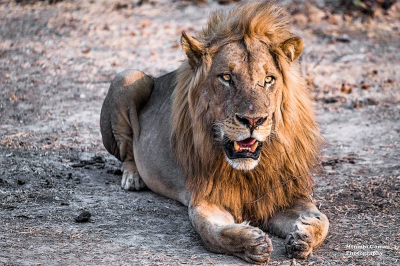|

This young pride male, part of a coalition of four males in the Chichele area of South Luangwa NATIONAL PARK was allegedly shot by trophy hunters according to the Mtumbi Goma Photography site.
Zambia recently opened lion hunting again after a short moratorium. The then Minister of Tourism and Arts, Jean Kapata established a quota of 24 adult male lions annually. This was supposed to be a “precautionary” quota and only allowed hunting of “old lions with diminished biological function”.
Sadly, Zambia does not have 24 such male lions of “reduced biological function” available per year. The quota was just a sop to the hunting companies who well know that in order to satisfy their clients the lions MUST be lured out of nationally protected areas. The quota was established based on the overall lion population of Zambia – and Kapata, having no real idea, assumed that there were between 1,500 to 2,500 lions in the country.
In Parliament Chongwe MP Silvia Masebo, the Minister of Tourism and Arts replaced by Kapata, mentioned that the country much more realistically only has about 400 lions as compiled from a diversity of researcher reports. We concur and hasten to point out that those 400 lions are of all ages and both sexes and largely resident in protected areas – and not available, therefore, for any hunting quota.
We met with Minister Masebo in July 2013 and supported her stance that lions were not well conserved in Zambia. Indeed, LionAid together with grassroots Zambian conservation organizations lobbied successfully to have lion hunting banned in early 2013. Minister Masebo also dismissed many in the Zambia Wildlife Authority, and said the following:
“There is a lot of cheating and corruption surrounding the wildlife hunting business which the Government has just banned. It is a lucrative sector which has seen a few individuals reap [profits] from wildlife products.
The Government is getting little in terms of revenue and the areas where this business is being conducted has for many years remained under-developed without any form of empowerment to the local people”.
As is typical in Africa, Ms Masebo was then accused of “corruption” herself and hounded out of office.
Lion population “estimates” have been flying around in Zambia for years. Some time ago, we published a report to indicate that Luangwa and Kafue contained perhaps 197 lions, and our information suggested that the Lower Zambezi contains perhaps 35 lions. The total for those three main lion conservation areas would therefore add up to 230 or so lions in Zambia. This was a far cry from ZAWA’s 2009 estimate of almost 3700 lions in those same three areas. And also a far cry from the IUCN number of 1750 lions.
Researchers working in South Luangwa had this to say about trophy hunting:
“Hunting resulted in population declines over a 25-yr period for all continuous harvest strategies, with large declines for quotas >1 lion/concession (~0.5 lion/1,000 km2) and hunting of males younger than seven years. A strategy that combined periods of recovery, an age limit of ≥7 yr, and a maximum quota of ~0.5 lions shot/1,000 km2 yielded a risk of extirpation <10%. Our analysis incorporated the effects of human encroachment, poaching, and prey depletion on survival, but assumed that these problems will not increase, which is unlikely. These results suggest conservative management of lion trophy hunting with a combination of regulations. To implement sustainable trophy hunting while maintaining revenue for conservation of hunting areas, our results suggest that hunting fees must increase as a consequence of diminished supply. These findings are broadly applicable to hunted lion populations throughout Africa and to inform global efforts to conserve exploited carnivore populations.”
The Zambian government took no heed of such recommendations, and the “7 year” rule is not enforceable. Zambia, like most other African countries where trophy hunting remains, leases hunting concessions that border directly onto national parks like South Luangwa. Such leases drain wildlife from national parks while their operators claim to be conducting trophy hunting in a “sustainable” manner.
It is high time that independent surveys take place in such hunting concessions and that quotas are assigned ONLY on the basis of such surveys. Trophy hunting quotas should NOT include protected area populations. If trophy hunters want to insist that their activities are “sustainable” they should only hunt what is available in their concessions.
We all know the story of how Romans threw Christians to the lions. Zambia seems to be throwing lions to the sport hunters without any concern about Zambia’s ever-declining lion population.
Picture credit: Mtumbi Goma Photography
| 



